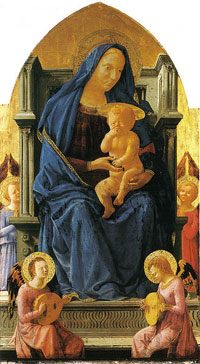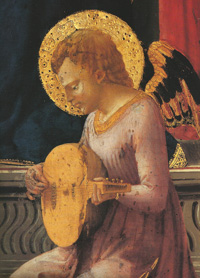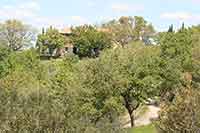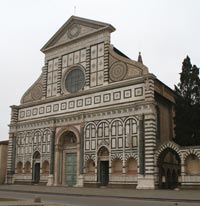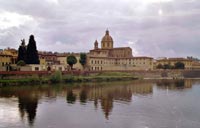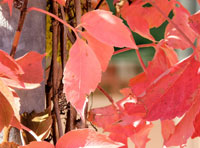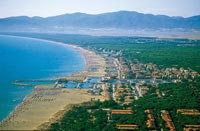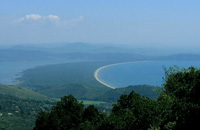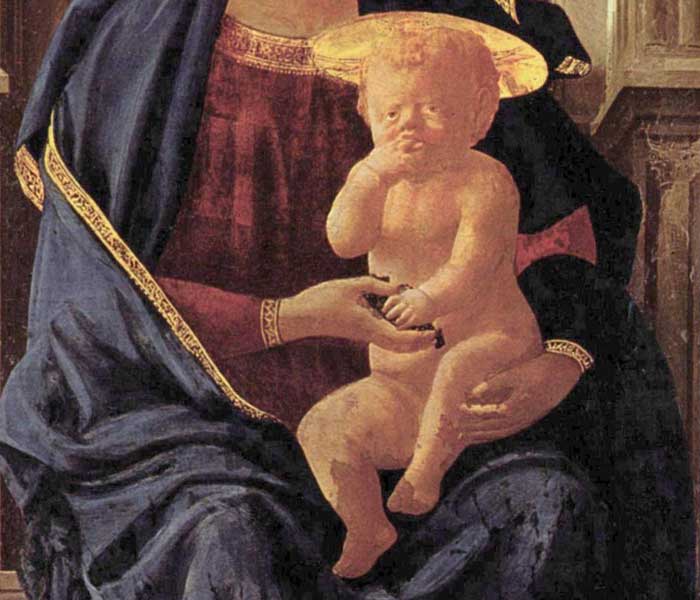 |
|
| Masaccio, Madonna with Child and Angels, 1426, egg tempera on poplar, 136 x 73 cm, National Gallery, London |
|
Madonna and Child with Angels |
| The Madonna and Child with Angels is a painting by the Italian Renaissance painter Masaccio, who worked in collaboration with his brother Giovanni and with Andrea di Giusto[1]. The format of this painting is unusually tall and narrow for the central composition of a polyptych of this date. The sides of the panel have been cut, although scholars cannot agree as to how much of the original has been lost. The gilt and tooled spandrels at the upper left and right would have been visible in the interstices of the original frame. The pointed arch of unworked wood marks the position of the missing frame that originally enclosed the Madonna from above. Its Gothic point is quaintly old-fashioned in comparison to the massive Renaissance throne.[0] * The faces are more realistic and not idealised.
|
||
Masaccio has used linear perspective to create pictorial space; it can be seen on the orthogonal on the cornice of her throne. The vanishing point is at the child's foot. The reason for this is that the work was originally located above a representation of the Adoration of the Magi, in which one of the magi kisses Jesus' foot. Although the paintings are noticeably different (the subjects are clothed differently and on different chairs) the Madonna is more or less in the same position in both works. |
|
|
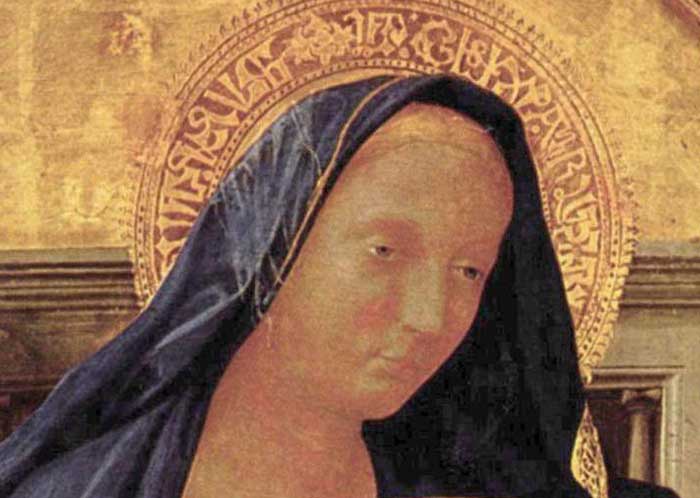 |
||
Masaccio, Madonna with Child and Angels (detail), 1426, egg tempera on poplar, 136 x 73 cm, National Gallery, London |
||
This Madonna and Child Enthroned reveals the progress that Masaccio made following the Brancacci Chapel toward the conquest of naturalistic representation. Probably no previous Madonna in Italian art had been portrayed with her face in semishadow; the light from the upper left falls fully on the child in her arms and, curiously, on the throne behind her head.[0]
|
||
| The Madonna with Child and Angels resembles the Hildburgh Madonna, a marble relief attributed to Donatello in the Victoria and Albert Museum, London, which Charles Avery dates to this period. In both the marble and the panel the lutes are represented in difficult foreshortenings, almos as if the sculptor and painter had engaged in a mutual challenge of virtuosity. Music-making angels had been a favorite motif in Florentine painting for some decades. Even a century later Vasari was struck by how Masaccio's angels seemed to listen to what they were playing. [6] Masaccio's innovations were not technical, for his work on panel uses traditional materials and methods, as do his paintings in fresco. Inspired by the ideals of Giotto, by contemporary interest in ancient Roman remains, by the recent experiments of his friends the architect-sculptor Brunelleschi and the sculptor Donatello, he relied above all on observation of nature. His study of perspective was allied to an equally profound analysis of light. The lutes of the two angels at the Virgin's feet are demonstrations, obviously studied from the model, of the joint effect of foreshortening and directional illumination. The peg box of the instrument on the right faces inwards, the other is turned towards us. The strong light shining from the upper left helps define rounded and flat surfaces and right angles, and the shadows and penumbras cast by the angels' hands look so natural that we almost take them for granted. Masaccio's egg tempera medium is deficient, when compared to contemporary Netherlandish oil paintings, in its ability to differentiate texture and lustre. But his grave vision of the structure of things seems all the weightier for lacking surface blandishments.
|
||
[0] John T. Spike, Masaccio, 1996, Abbeville Press Inc, pp. 142-143 [1] Masaccio (1401-1427?), the first great painter of the Italian Renaissance, whose innovations in the use of scientific perspective inaugurated the modern era in painting. Masaccio, originally named Tommaso Cassai, was born in San Giovanni Valdarno, near Florence, on December 21, 1401. He joined the painters guild in Florence in 1422. His remarkably individual style owed little to other painters, except possibly the great 14th-century master Giotto. He was more strongly influenced by the architect Brunelleschi and the sculptor Donatello, both of whom were his contemporaries in Florence. From Brunelleschi he acquired a knowledge of mathematical proportion that was crucial to his revival of the principles of scientific perspective. From Donatello he imbibed a knowledge of classical art that led him away from the prevailing Gothic style. He inaugurated a new naturalistic approach to painting that was concerned less with details and ornamentation than with simplicity and unity, less with flat surfaces than with the illusion of three dimensionality. Together with Brunelleschi and Donatello, he was a founder of the Renaissance. Only four unquestionably attributable works of Masaccio survive, although various other paintings have been attributed in whole or in part to him. All of his works are religious in nature-altarpieces or church frescoes. The earliest, a panel, the Madonna with St. Anne (circa 1423, Uffizi, Florence), shows the influence of Donatello in its realistic flesh textures and solidly rounded forms. The fresco Trinity (c. 1425, Santa Maria Novella, Florence) used full perspective for the first time in Western art. His altarpiece for Santa Maria del Carmine, Pisa (1426), with its central panel of the Adoration of the Magi (now in the Staatliche Museen, Berlin), was a simple, unadorned version of a theme that was treated by other painters in a more decorative, ornamental manner. The fresco series for the Brancacci Chapel in Santa Maria del Carmine, Florence (about 1427) illustrates another of his great innovations, the use of light to define the human body and its draperies. In these frescoes, rather than bathing his scenes in flat uniform light, he painted them as if they were illuminated from a single source of light (the actual chapel window), thus creating a play of light and shadow (chiaroscuro) that gave them a natural, realistic quality unknown in the art of his day. Of these six fresco scenes, Tribute Money and the Expulsion from Paradise are considered his masterpieces. Masaccio's work exerted a strong influence on the course of later Florentine art and particularly on the work of Michelangelo. He died in Rome in 1427 or 1428. [2] Jill Dunkerton and Dillian Gordon, "The Pisa Altarpiece," in Carl Brandon Strehlke, ed.The Panel Paintings of Masolino and Masaccio: The Role of Technique, Milan, 2002, 91-93. [3] Documents published in James Beck, Masaccio: The Documents, Locust Valley, NY, 1978, Appendix, 31-50. [4]Giorgio Vasari, Le vite de' più eccellenti pittori, scultori ed architettori, ed. Gaetano Milanesi, Florence, 1906, II, 292. [5] Jill Dunkerton et.al., Giotto to Dürer: Early Renaissance Painting in the National Gallery, New Haven, 1991, 248-251. [6] John T. Spike, Masaccio, 1996, Abbeville Press Inc, pp. 142-143. On the basis of Vasari, Poggi perceptively intuited in 1903 that the lost Carmine Madonna would have had a Donatellian character.
This article incorporates material from the Wikipedia article Madonna and Child (Masaccio) published under the GNU Free Documentation License. |
||
|
||||
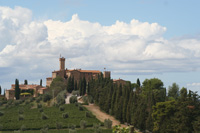 |
||||
Castello Banfi |
Podere Santa Pia |
Podere Santa Pia, garden view, April |
||
 |
||||
Santa Maria Novella a Firenze |
Castello Banfi |
Santa Maria del Carmine, Firenze |
||
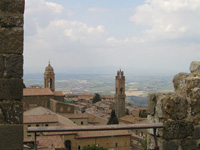 |
||||
Podere Santa Pia, garden view, December |
Perugia
|
Montalcino |
||
The central location of the wonderful holiday home allows you to visit the nearby beautiful villages Montalcino, Sant'Antimo, Pienza, S. Quirico d'Orcia and in the south Saturnia and Sorano - known for its beautiful Sasso Leopoldo. And the sea is 38km away in Marina di Grosseto. Tuscany Beaches in Maremma | [1] From Principina a Mare to Piombino
|
||||
 |
||||
Marina di Grosseto |
Tombolo di Feniglia |
View from Santa Pia on the coast and Monte Christo and even Corsica |
||
|
||||
| Parco Naturale della Maremma |
||||
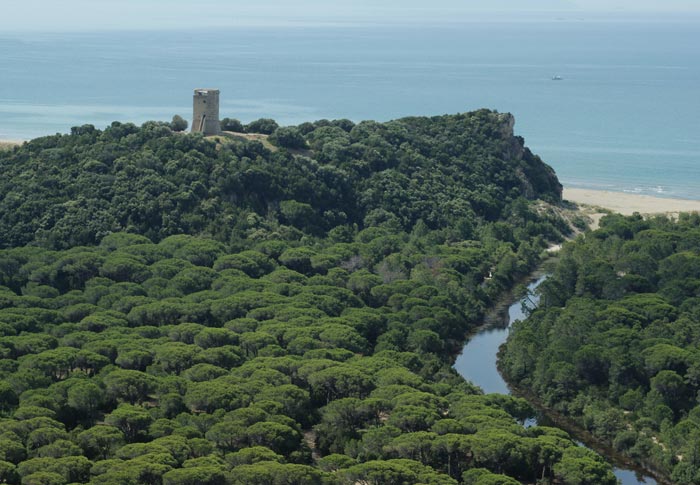 |
||||
| The Maremma distinguishes itself from other areas of Italy thanks to its variety and wealth of natural environments. In order to protect them, many natural reserves and parks have been established. There you can enjoy the Mediterranean scrub in all its infinite variations, not to mention the possibility of seeing wildlife of the area. In Maremma the reserves, parks and the oases occupy approximately 40.000 hectares.The most known it is Maremma Natural Park, extended for approximately 100 kmq, and comprise the stretch of Tuscan Maremma coast which goes from Principina up to Talamone, and it is delimited by the Aurelia road. The main part of the Park is characterised by the Uccellina Mountains, a chain of hills that "run" parallel to the coast and covered by the thick Mediterranean maquis, which ends with the Lecci Hill ( Poggio Lecci) 417 meters on the sea level. The northern area (plain) is humid with flood-lands formed by the sediments trasported by the river Ombrone. Other important ecosystem is represented from the pineta situated in Marina of Alberese, result of the reforestation made in the past from Leopoldo II of Lorena. The coastal feature instead is constituted from a succession of runs aground them. The park represents an ideal natural habitat for horse and bovines. In the enviroments of the pastures moreover they live stabily hares, foxes, porcupines, wild boars. The coast, the beaches and the sea of the Tuscan Maremma | Parco Naturale della Maremma |
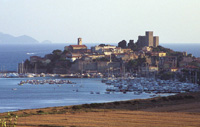 Talamone |
|||
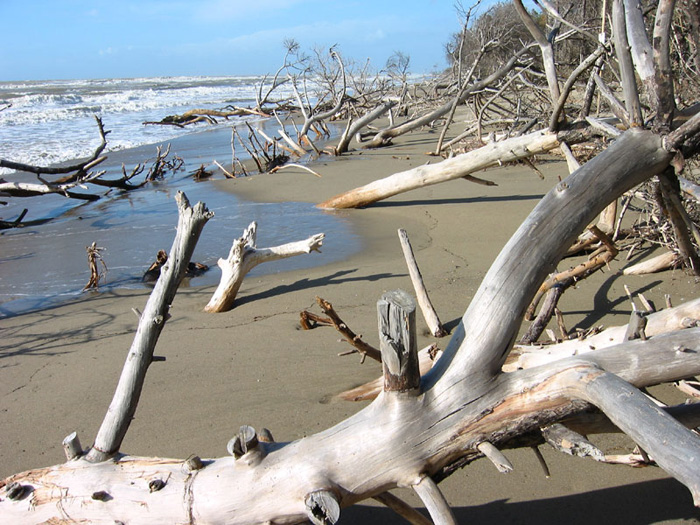 |
||||

